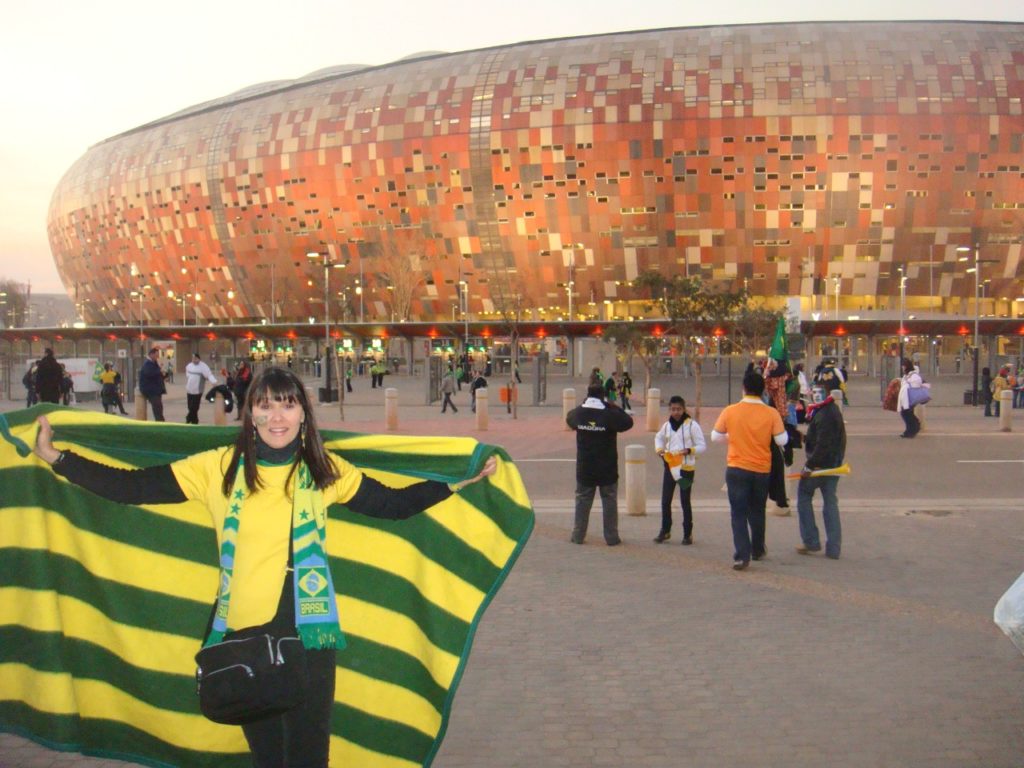São Paulo – Ynara Correa Costa is almost packed and ready to go to her sixth World Cup. Born and raised in Campo Grande, Mato Grosso do Sul, until her teenage years, the systems analyst who now lives in Cotia, São Paulo, first fell in love with football when she was 16 by influence of her Corinthians fan friends. “I didn’t even like football when I went to watch a Corinthians vs. Palmeiras match. That is the day I became a Corinthians fan, then I started watching its matches every week.”
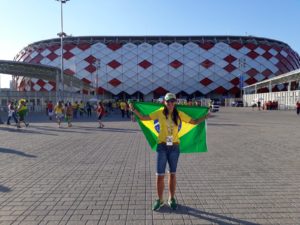
Following her dream to participate in a World Cup, she went to the United States in 1994. Traveling abroad by herself for the first time, the 23-year-old paid to watch the last 10 days of the competition with her intern salary. “I was very lucky to watch four games of Brazil, and the country became a four-time champion that year. I really enjoyed the matches I watched with the Brazilian friends I made there,” Costa finishes.
After the Cup, she kept wanting to watch other championships and was able to go to the 1998 Cup in France, the 2010 Cup in South Africa (opening picture), the 2014 Cup in Brazil and the 2018 Cup in Russia. In each and every country, Costa lived a different cheering experience. In South Africa, she says she noticed many similarities with Brazil regarding its people and social issues. In Russia, where she fell in love with the beauty and warmth of the population, she had to travel around a lot to get to the stadiums. “Brazil’s Cup, which many said would be disorganized, was better than I expected. Well, except for the Brazilian team that lost to Germany.”
Another football fan that is going to watch the Qatar Cup is 66-year-old Fernando Antônio Abrahão. Born in São Paulo and residing in Nova Friburgo, Rio de Janeiro, since 1997, the retired wholesaler is ready to watch his third World Cup. Just like Costa, the first time he left Brazil was to watch a World Cup. “I watched the full 2006 Cup in Germany. It was all so new, all by myself, I didn’t know anybody, but it fantastic. I made some friend and had my 50th birthday there. In 2018 I came back to watch another full Cup in Russia.”
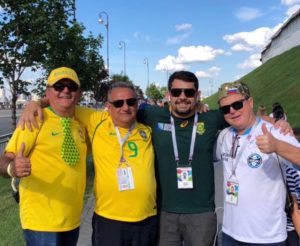
Born back when Pelé was the country’s best player, Abrahão was also influenced by his friends to like football. “Just like any child, I chose Santos because it was a winning team. I went often to Vila Belmiro to watch my team play, but that became harder when I moved to Nova Friburgo. But I watched the 2011 FIFA Club World Cup where Santos lost to Barcelona in Japan, and whenever it comes to play matches around here, I go.”
Since his wife and kids don’t like football as much as he does, he went to Germany alone and ended up making friends with some people from Rio Grande do Sul and Pará. In his second Cup, Abrahão went by himself again, this time to Russia and enjoyed the games with the same group from 2006. At the Qatar’s Cup, he’ll also go alone from here and meet some friends there in the Arab country. “Since 1970, when the Cup was first broadcasted, I had the dream to watch a world tournament in person.”
Just like Abrahão, Costa is used to go to the World Cups by herself. In 1998, she bought a package from a travel agency and ended up making friends with the other people that went with her. In her second and fifth Cups, she enjoyed the matches unaccompanied. As for South Africa, she went with her friends, and in Brazil’s Cup she decided to watch some of the matches with her 11-year-old son, so that he had the chance to participate in this type of celebration. “Although I’m in love with football, the Cup for me is not only about football, it’s about the confraternization between all countries. I really like the before and after of the match, as the party of people is what makes the difference for me.”
Prices and organization to see the matches
Costa says that she spends an average of BRL 400 (USD 75) with football, and she always like to watch the matches of her team, and she even went to the final of the 2012 FIFA World Cup, when Corinthians beat Chelsea in Japan. To watch the competition without hindering her work, she always uses her vacations to travel. In Qatar, she arranged to watch the matches until the final.
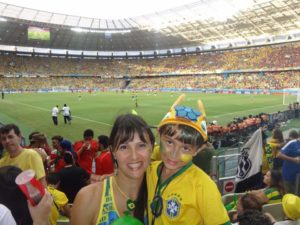
Costa, who always starts saving money for the flight, accommodation and matches a year in advance, is paying this Cup in several installments. She spent way over USD 20,000 to watch the games in Qatar, where she’ll arrive on November 18.
Having bought over 20 match tickets, Costa is going to Qatar mainly to watch the matches, but whenever she has a downtime, she’ll try and get to know the country. But this is not the first time she will visit it. Last month she spent four days there, at the invitation of the International Federation of Association Football (FIFA). The system analyst was the only Brazilian invited by the Cup Supreme Committee through the Fan Leaders program. “They recruited fans from across the world to take a tour around the country and give feedback about the preparations.
Costa expects Brazil will get to the final because it has a strong team. But even if the Brazilian football team loses before the final, she’s excited to watch it.

For financial reasons, Abrahão will watch only the first phase in Qatar. He will see Brazil’s first three matches and three matches of other countries. The cost of tickets, accommodation and matches reached approximately USD 45,000 that he had saved prior to the trip. “Due to the pandemic, we didn’t know if we were going to the Cup, so we decided to go at the last minute. Dollar was high, so it was quite pricey.”
Over the 12 day period he will spend in Doha, Qatar, and other four days in Dubai, United Arab Emirates, that he will take the chance to visit, Abrahão expects to spent more USD 10,000 with food, tours and shopping. The trip was purchased with agency Stella Barros.
The two Brazilians plan on going to the 2026 World Cup to be hosted for the first time by three countries — Canada, US and Mexico.
Qatar’s Cup official agency
At Grupo Águia, Qatar’s World Cup official accommodation agency, trips to Qatar’s World Cup started being sold in March 2021 and are almost sold out.
Paulo Castello Branco, Special Project president of Grupo Águia, says that the Match Hospitality service the company is responsible for includes hospitality, VIP packages for Brazil’s and other team’s matches that include fine dining and open bar, pick up and drop off at the airport in the Arab country, and an off-site tourist program in Qatar.
“We’re the official agents, and we name three subagents to sell the World Cup with us. Stella Barros, which is a company in our group, sold leisure activities, Top Service sold incentives packages for major corporations that gave the trip away to groups of 40 to 100 employees, and CVC,” Branco says.

Values varied greatly depending on the phase of the competition the football fan would watch. The closer to the final, the higher the prices of the packages.
To get an idea, the Match Club category (the simplest VIP package) for the Cup’s group phase cost USD 9,315, while the Business Seat category (the most premium VIP package) cost USD 11,415. The most basic category for the final cost USD 12,665.40, while the top cabin reached USD 21,960. Brazil will take approximately 1,700 people to see the World Cup.
The travel packages of Grupo Águia has a duration of four nights. Those who will watch the first phase of the competition will travel from Brazil on November 20, arriving the next day in Qatar. On the 22nd they will go off site, on the 23rd they will watch the extra match, on the 24th they watch Brazil’s match, and on the 25th they return to the country.
As the games are more widely spaced, those who’ll watch the quarterfinals will spend five nights in the Arab country. Although it doesn’t officially sell air tickets, the group signed a partnership with airlines like Qatar Airways to cater to clients who’d like to purchase the travel packages with the tickets.
Branco says that most clients preferred to do so. But since people chose different flight categories on different days, the ticket price varied considerably.
Profiles of football fans
According to Branco, the profiles of football fans that are going to the Cup were mixed, ranging from companies to groups of four to eight friends that have been to other competitions like this. But most of the fans are families with children. “It’s very rare to see someone going alone to the World Cup. They usually go with a sibling, a friend,” Branco says.
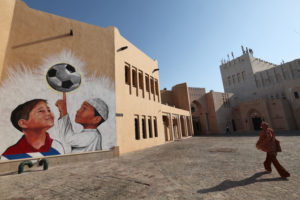
Due to the high costs and dollar prices, the average age of buyers was over 40 years. “I know it’s an expensive travel, but after the 2014 Cup, the Brazilians understood that the world tournament is about more than just football, they saw it’s a confraternization of peoples, a great party, the world’s greatest event, bigger than the Olympics,” he says.
The mitigation of the pandemic was responsible for increasing the people’s desire to go to the Cup. According to Branco, travelers planned in advance. In March last year, when the packages started being sold, travelers could split the amount in up to 13 installments.
Most participants will watch the first phase of matches, as it is guaranteed that Brazil will play, but if the country proceeds to the next phases, the demand to watch the final games will increase, Branco believes.
As for the costs, prices are high. “I believe people that are going to the Cup will spend a lot with food and shopping. It’s a very rich region, near the UAE and Saudi Arabia.”
Taking advantage of the proximity of other tourist countries, several people bought group packages to extend the trip. “We’re taking 400 people to an after-Cup trip to Dubai. Some people are going to Maldives, India, Israel, and others are going to spend some time in Europe after the games.”
*Special report by Rebecca Vettore for ANBA
Translated by Guilherme Miranda



